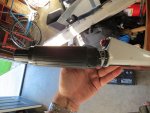I purchased a 15 horse 1991 Johnson long shaft outboard engine, model J15REIA, at a garage sale over the summer that did not start. According to the guy I bought it from, it ran fine the last time it was in the water, but had sat for several years without being run. It turns over fine, so I figured that the carb was just gummed up & that I'd be able to clean it up and get it running.
To begin with, I built a stand for it and proceeded to clean everything. Zebra mussels, grease, dirt, gunk, etc - all gone and the motor is nice & clean now. While doing so, I noticed that the shaft that controls the choke was not connected to the lever inside that actuates the butterfly! Could it be that's all that was wrong with this engine?!???
Unfortunately no. I put the lever in the groove in the plastic shaft & it would not start. I proceeded to do basic troubleshooting and discovered two things.
1) It has no spark. Replacing the spark plugs did nothing and grounding a plug against the engine & pulling resulted in no spark jumping the plug gap.
2) It pulls considerably harder than my 1985 25 horse electric start Evinrude when using the rope instead of the starter.
While I understand the principles involved and pick things up quickly, I am not nearly as good with 2-cycle engines as I am with 4-stroke. I believe the first issue to start troubleshooting has got to be the spark issue, but don't really know where to begin. I would like to get this engine going so that I can have it for either a kicker or backup to my Evinrude. (Evinrude wouldn't start this spring, but I was able to fix it.) I certainly don't mind getting my hands dirty and spending time working to figure things out, but also don't want to sink hundreds of dollars into it. I have an old outboard manual that covers 2-40 horse Johnson/Evinrude engines from 1973-1990, but it obviously stops one year too soon and is rather hard to follow given all the different engines it covers.
Could anybody make recommendations of what my next step should be?
To begin with, I built a stand for it and proceeded to clean everything. Zebra mussels, grease, dirt, gunk, etc - all gone and the motor is nice & clean now. While doing so, I noticed that the shaft that controls the choke was not connected to the lever inside that actuates the butterfly! Could it be that's all that was wrong with this engine?!???
Unfortunately no. I put the lever in the groove in the plastic shaft & it would not start. I proceeded to do basic troubleshooting and discovered two things.
1) It has no spark. Replacing the spark plugs did nothing and grounding a plug against the engine & pulling resulted in no spark jumping the plug gap.
2) It pulls considerably harder than my 1985 25 horse electric start Evinrude when using the rope instead of the starter.
While I understand the principles involved and pick things up quickly, I am not nearly as good with 2-cycle engines as I am with 4-stroke. I believe the first issue to start troubleshooting has got to be the spark issue, but don't really know where to begin. I would like to get this engine going so that I can have it for either a kicker or backup to my Evinrude. (Evinrude wouldn't start this spring, but I was able to fix it.) I certainly don't mind getting my hands dirty and spending time working to figure things out, but also don't want to sink hundreds of dollars into it. I have an old outboard manual that covers 2-40 horse Johnson/Evinrude engines from 1973-1990, but it obviously stops one year too soon and is rather hard to follow given all the different engines it covers.
Could anybody make recommendations of what my next step should be?























